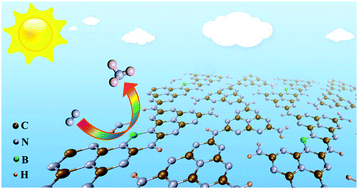A boron-decorated melon-based carbon nitride as a metal-free photocatalyst for N2 fixation: a DFT study†
Abstract
On the basis of the electron “acceptance-donation” concept, a boron decorated melon-based carbon nitride (CN) is studied as a metal-free photocatalyst to efficiently reduce N2 to NH3 under visible light irradiation. The results revealed that a boron-interstitial (Bint)-decorated melon-based CN has an outstanding N2 reduction capacity through the enzymatic mechanism with a rather low overpotential (0.32 V). The excellent efficiency and selectivity of Bint-decorated melon-based CN in N2 reduction reaction (NRR) are attributed to the concentrated spin polarization on the B atom, the significant enhancement of visible and infrared light absorption, and the effective inhibition of the competitive hydrogen evolution reaction (HER). Importantly, B-doped melon-based CN has been successfully synthesized in the experiments, so obtaining Bint-decorated melon is promising, while proton transfer from the –NH2 group in CN to the B atom surely will affect the functionality of the catalyst through deactivation of the N2 adsorption site. Our study provides a novel single atom metal-free photocatalyst with high efficiency for NRR, which is conducive to the sustainable synthesis of ammonia.



 Please wait while we load your content...
Please wait while we load your content...